Related Research Articles
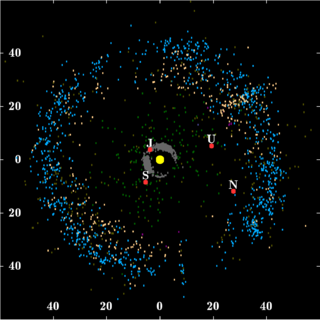
The Kuiper belt is a circumstellar disc in the outer Solar System, extending from the orbit of Neptune at 30 astronomical units (AU) to approximately 50 AU from the Sun. It is similar to the asteroid belt, but is far larger—20 times as wide and 20–200 times as massive. Like the asteroid belt, it consists mainly of small bodies or remnants from when the Solar System formed. While many asteroids are composed primarily of rock and metal, most Kuiper belt objects are composed largely of frozen volatiles, such as methane, ammonia, and water. The Kuiper belt is home to most of the objects that astronomers generally accept as dwarf planets: Orcus, Pluto, Haumea, Quaoar, and Makemake. Some of the Solar System's moons, such as Neptune's Triton and Saturn's Phoebe, may have originated in the region.

A terrestrial planet, telluric planet, or rocky planet, is a planet that is composed primarily of silicate, rocks or metals. Within the Solar System, the terrestrial planets accepted by the IAU are the inner planets closest to the Sun: Mercury, Venus, Earth and Mars. Among astronomers who use the geophysical definition of a planet, two or three planetary-mass satellites – Earth's Moon, Io, and sometimes Europa – may also be considered terrestrial planets. The large rocky asteroids Pallas and Vesta are sometimes included as well, albeit rarely. The terms "terrestrial planet" and "telluric planet" are derived from Latin words for Earth, as these planets are, in terms of structure, Earth-like. Terrestrial planets are generally studied by geologists, astronomers, and geophysicists.

Planetesimals are solid objects thought to exist in protoplanetary disks and debris disks. Believed to have formed in the Solar System about 4.6 billion years ago, they aid study of its formation.

The nebular hypothesis is the most widely accepted model in the field of cosmogony to explain the formation and evolution of the Solar System. It suggests the Solar System is formed from gas and dust orbiting the Sun which clumped up together to form the planets. The theory was developed by Immanuel Kant and published in his Universal Natural History and Theory of the Heavens (1755) and then modified in 1796 by Pierre Laplace. Originally applied to the Solar System, the process of planetary system formation is now thought to be at work throughout the universe. The widely accepted modern variant of the nebular theory is the solar nebular disk model (SNDM) or solar nebular model. It offered explanations for a variety of properties of the Solar System, including the nearly circular and coplanar orbits of the planets, and their motion in the same direction as the Sun's rotation. Some elements of the original nebular theory are echoed in modern theories of planetary formation, but most elements have been superseded.

A protoplanetary disk is a rotating circumstellar disc of dense gas and dust surrounding a young newly formed star, a T Tauri star, or Herbig Ae/Be star. The protoplanetary disk may also be considered an accretion disk for the star itself, because gases or other material may be falling from the inner edge of the disk onto the surface of the star. This process should not be confused with the accretion process thought to build up the planets themselves. Externally illuminated photo-evaporating protoplanetary disks are called proplyds.

A proplyd, short for ionized protoplanetary disk, is an externally illuminated photoevaporating protoplanetary disk around a young star. Nearly 180 proplyds have been discovered in the Orion Nebula. Images of proplyds in other star-forming regions are rare, while Orion is the only region with a large known sample due to its relative proximity to Earth.
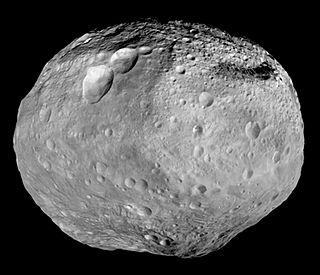
A protoplanet is a large planetary embryo that originated within a protoplanetary disk and has undergone internal melting to produce a differentiated interior. Protoplanets are thought to form out of kilometer-sized planetesimals that gravitationally perturb each other's orbits and collide, gradually coalescing into the dominant planets.

Planetary migration occurs when a planet or other body in orbit around a star interacts with a disk of gas or planetesimals, resulting in the alteration of its orbital parameters, especially its semi-major axis. Planetary migration is the most likely explanation for hot Jupiters. The generally accepted theory of planet formation from a protoplanetary disk predicts that such planets cannot form so close to their stars, as there is insufficient mass at such small radii and the temperature is too high to allow the formation of rocky or icy planetesimals.

In astrophysics, accretion is the accumulation of particles into a massive object by gravitationally attracting more matter, typically gaseous matter, into an accretion disk. Most astronomical objects, such as galaxies, stars, and planets, are formed by accretion processes.

An ice giant is a giant planet composed mainly of elements heavier than hydrogen and helium, such as oxygen, carbon, nitrogen, and sulfur. There are two ice giants in the Solar System: Uranus and Neptune.

There is evidence that the formation of the Solar System began about 4.6 billion years ago with the gravitational collapse of a small part of a giant molecular cloud. Most of the collapsing mass collected in the center, forming the Sun, while the rest flattened into a protoplanetary disk out of which the planets, moons, asteroids, and other small Solar System bodies formed.
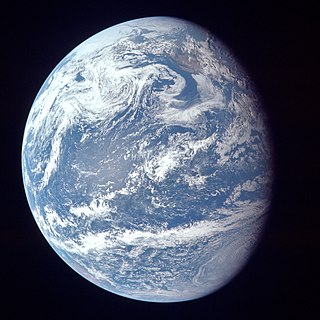
An ocean world, ocean planet or water world is a type of planet that contains a substantial amount of water in the form of oceans, as part of its hydrosphere, either beneath the surface, as subsurface oceans, or on the surface, potentially submerging all dry land. The term ocean world is also used sometimes for astronomical bodies with an ocean composed of a different fluid or thalassogen, such as lava, ammonia or hydrocarbons. The study of extraterrestrial oceans is referred to as planetary oceanography.

HD 113766 is a binary star system located 424 light years from Earth in the direction of the constellation Centaurus. The star system is approximately 10 million years old and both stars are slightly more massive than the Sun. The two are separated by an angle of 1.3 arcseconds, which, at the distance of this system, corresponds to a projected separation of at least 170 AU.

The Nicemodel is a scenario for the dynamical evolution of the Solar System. It is named for the location of the Côte d'Azur Observatory—where it was initially developed in 2005—in Nice, France. It proposes the migration of the giant planets from an initial compact configuration into their present positions, long after the dissipation of the initial protoplanetary disk. In this way, it differs from earlier models of the Solar System's formation. This planetary migration is used in dynamical simulations of the Solar System to explain historical events including the Late Heavy Bombardment of the inner Solar System, the formation of the Oort cloud, and the existence of populations of small Solar System bodies such as the Kuiper belt, the Neptune and Jupiter trojans, and the numerous resonant trans-Neptunian objects dominated by Neptune.
The five-planet Nice model is a numerical model of the early Solar System that is a revised variation of the Nice model. It begins with five giant planets, the four that exist today plus an additional ice giant between Saturn and Uranus in a chain of mean-motion resonances.

In planetary astronomy, the grand tack hypothesis proposes that Jupiter formed at a distance of 3.5 AU from the Sun, then migrated inward to 1.5 AU, before reversing course due to capturing Saturn in an orbital resonance, eventually halting near its current orbit at 5.2 AU. The reversal of Jupiter's planetary migration is likened to the path of a sailboat changing directions (tacking) as it travels against the wind.
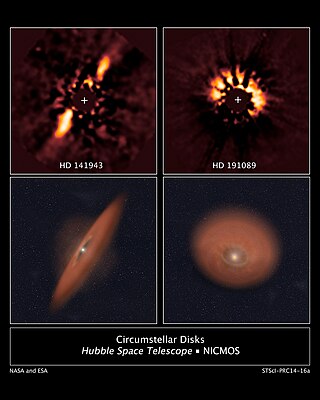
A circumstellar disc is a torus, pancake or ring-shaped accretion disk of matter composed of gas, dust, planetesimals, asteroids, or collision fragments in orbit around a star. Around the youngest stars, they are the reservoirs of material out of which planets may form. Around mature stars, they indicate that planetesimal formation has taken place, and around white dwarfs, they indicate that planetary material survived the whole of stellar evolution. Such a disc can manifest itself in various ways.

Pebble accretion is the accumulation of particles, ranging from centimeters up to meters in diameter, into planetesimals in a protoplanetary disk that is enhanced by aerodynamic drag from the gas present in the disk. This drag reduces the relative velocity of pebbles as they pass by larger bodies, preventing some from escaping the body's gravity. These pebbles are then accreted by the body after spiraling or settling toward its surface. This process increases the cross section over which the large bodies can accrete material, accelerating their growth. The rapid growth of the planetesimals via pebble accretion allows for the formation of giant planet cores in the outer Solar System before the dispersal of the gas disk. A reduction in the size of pebbles as they lose water ice after crossing the ice line and a declining density of gas with distance from the sun slow the rates of pebble accretion in the inner Solar System resulting in smaller terrestrial planets, a small mass of Mars and a low mass asteroid belt.
In planetary science a streaming instability is a hypothetical mechanism for the formation of planetesimals in which the drag felt by solid particles orbiting in a gas disk leads to their spontaneous concentration into clumps which can gravitationally collapse. Small initial clumps increase the orbital velocity of the gas, slowing radial drift locally, leading to their growth as they are joined by faster drifting isolated particles. Massive filaments form that reach densities sufficient for the gravitational collapse into planetesimals the size of large asteroids, bypassing a number of barriers to the traditional formation mechanisms. The formation of streaming instabilities requires solids that are moderately coupled to the gas and a local solid to gas ratio of one or greater. The growth of solids large enough to become moderately coupled to the gas is more likely outside the ice line and in regions with limited turbulence. An initial concentration of solids with respect to the gas is necessary to suppress turbulence sufficiently to allow the solid to gas ratio to reach greater than one at the mid-plane. A wide variety of mechanisms to selectively remove gas or to concentrate solids have been proposed. In the inner Solar System the formation of streaming instabilities requires a greater initial concentration of solids or the growth of solid beyond the size of chondrules.
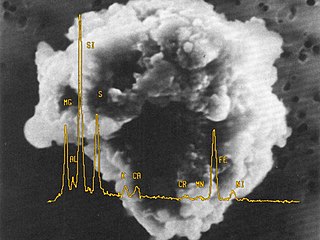
Dust astronomy is a subfield of astronomy that uses the information contained in individual cosmic dust particles ranging from their dynamical state to its isotopic, elemental, molecular, and mineralogical composition in order to obtain information on the astronomical objects occurring in outer space. Dust astronomy overlaps with the fields of Planetary science, Cosmochemistry, and Astrobiology.
References
- ↑ Qi, Chunhua; Oberg, Karin I.; Wilner, David J.; d'Alessio, Paola; Bergin, Edwin; Andrews, Sean M.; Blake, Geoffrey A.; Hogerheijde, Michiel R.; van Dishoeck, Ewine F. (2013). "Imaging of the CO Snow Line in a Solar Nebula Analog by Chunhua Qi, Karin I. Oberg, et al". Science. 341 (6146): 630–2. arXiv: 1307.7439 . Bibcode:2013Sci...341..630Q. doi:10.1126/science.1239560. PMID 23868917. S2CID 23271440.
- ↑ Dartois, E.; Engrand, C.; Brunetto, R.; Duprat, J.; Pino, T.; Quirico, E.; Remusat, L.; Bardin, N.; Briani, G.; Mostefaoui, S.; Morinaud, G.; Crane, B.; Szwec, N.; Delauche, L.; Jamme, F.; Sandt, Ch.; Dumas, P. (2013). "UltraCarbonaceous Antarctic micrometeorites, probing the Solar System beyond the nitrogen snow-line by E. Dartois, et al". Icarus. 224 (1): 243–252. Bibcode:2013Icar..224..243D. doi:10.1016/j.icarus.2013.03.002.
- ↑ Öberg, K.I.; Wordsworth, R. (2019). "Jupiter's Composition Suggests its Core Assembled Exterior to the N_{2} Snowline". The Astronomical Journal. 158 (5). arXiv: 1909.11246 . doi: 10.3847/1538-3881/ab46a8 . S2CID 202749962.
- ↑ "Structure of the Solar Nebula, Growth and Decay of Magnetic Fields and Effects of Magnetic and Turbulent Viscosities on the Nebula by Chushiro Hayashi". Archived from the original on 2015-02-19.
- ↑ Podolak, M.; Zucker, S. (2004). "A note on the snow line in protostellar accretion disks by M. PODOLAK and S. ZUCKER, 2010". Meteoritics & Planetary Science. 39 (11): 1859. Bibcode:2004M&PS...39.1859P. doi: 10.1111/j.1945-5100.2004.tb00081.x . S2CID 55193644.
- 1 2 Martin, Rebecca G.; Livio, Mario (2012). "On the Evolution of the Snow Line in Protoplanetary Discs by Rebecca G. Martin, Mario Livio (STScI)". Monthly Notices of the Royal Astronomical Society: Letters. 425 (1): L6. arXiv: 1207.4284 . Bibcode:2012MNRAS.425L...6M. doi:10.1111/j.1745-3933.2012.01290.x. S2CID 54691025.
- ↑ D'Angelo, G.; Podolak, M. (2015). "Capture and Evolution of Planetesimals in Circumjovian Disks". The Astrophysical Journal. 806 (1): 29pp. arXiv: 1504.04364 . Bibcode:2015ApJ...806..203D. doi:10.1088/0004-637X/806/2/203. S2CID 119216797.
- ↑ Zhang, Yu; Jin, Liping (March 2015). "The Evolution of the Snow Line in a Protoplanetary Disk". The Astrophysical Journal. 802 (1). id. 58. Bibcode:2015ApJ...802...58Z. doi:10.1088/0004-637X/802/1/58.
- ↑ Jewitt, D.; Chizmadia, L.; Grimm, R.; Prialnik, D. (2007). "Water in the Small Bodies of the Solar System" (PDF). In Reipurth, B.; Jewitt, D.; Keil, K. (eds.). Protostars and Planets V. University of Arizona Press. pp. 863–878. ISBN 978-0-8165-2654-3.
- ↑ McCord, T. B.; Sotin, C. (2005-05-21). "Ceres: Evolution and current state". Journal of Geophysical Research: Planets. 110 (E5): E05009. Bibcode:2005JGRE..110.5009M. doi: 10.1029/2004JE002244 .
- ↑ O'Brien, D. P.; Travis, B. J.; Feldman, W. C.; Sykes, M. V.; Schenk, P. M.; Marchi, S.; Russell, C. T.; Raymond, C. A. (March 2015). "The Potential for Volcanism on Ceres due to Crustal Thickening and Pressurization of a Subsurface Ocean" (PDF). 46th Lunar and Planetary Science Conference . p. 2831. Retrieved 1 March 2015.
- ↑ Kaufmann, William J. (1987). Discovering the Universe . W.H. Freeman and Company. p. 94. ISBN 978-0-7167-1784-3.
- ↑ Chambers, John (2007-07-01). "Planet Formation with Type I and Type II Migration". 38. AAS/Division of Dynamical Astronomy Meeting. Bibcode 2007DDA....38.0604C.
- ↑ D'Angelo, Gennaro; Durisen, Richard H.; Lissauer, Jack J. (December 2010). "Giant Planet Formation". In Seager, Sara (ed.). Exoplanets. University of Arizona Press. pp. 319–346. arXiv: 1006.5486 . Bibcode:2010exop.book..319D. ISBN 978-0-8165-2945-2.
- ↑ "Asteroid Belts of Just the Right Size are Friendly to Life". NASA. 1 November 2012. Retrieved 3 November 2012.
- ↑ Owen, James E. (2020). "Snow-lines can be thermally unstable". Monthly Notices of the Royal Astronomical Society. 495 (3): 3160–3174. arXiv: 2005.03665 . doi:10.1093/mnras/staa1309.